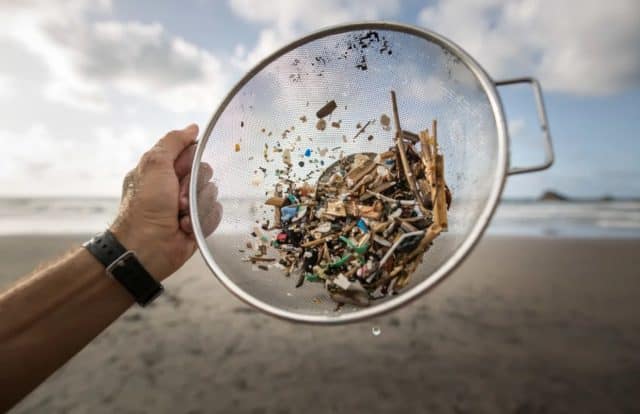Plastic pollution is an ever growing crisis of our time. We are now finding microplastic (small plastic pieces less than five millimeters in length) in the deepest parts of our oceans, in the snow and streams of our highest peaks and even in our unborn children.
Microplastics originate from many different sources. They can be designed like microbeads that are found in personal care products (microbeads have now been banned in the US, UK and Canada) or they come from larger pieces of plastic that have degraded from environmental conditions such as heat, wind or water.

Eco-Stylist is reader-supported. If you make a purchase using our links, we may earn a commission. We only feature fashion brands that pass our sustainable brand criteria. Learn more here.
As consumers, we must be actively conscious about our plastic consumption and work on finding plastic-free alternatives to our purchases. Below are three actions we can take now to play a part in reducing microplastic pollution:
1. Look for clothing made of natural materials:
Recent estimates show that 35% of microplastic pollution is attributed to synthetic clothing like polyester, nylon and acrylic. These materials shed plastic microfibers over their lifespans, particularly when they are being washed.

Synthetic materials make up 60% of the materials in our clothing worldwide. We can drastically reduce our plastic pollution footprint by starting with what we wear. When looking for clothes, try to shop for items that are made up of any of the following natural materials:
- Cotton (preferably organic, recycled or FairTrade)
- Tencel Lyocell (Tencel is a sustainably sourced brand of lyocell)
- Linen (preferably organic)
- Hemp (preferably organic)
- Recycled or responsibly sourced wool and cashmere
*For more information, check out Eco-Stylist’s Guide to the Most and Least Sustainable Fabrics.
2. If you do own synthetic clothing, use GuppyFriend Washing Bag when doing laundry:

Each time we wash our synthetic clothes in a washing machine, hundreds of thousands of microfibers are released into our water systems, a great percentage of which make their way into the oceans.” One great product that can serve as a solution to mitigating microplastic pollution is the GuppyFriend Washing Bag.
This scientifically-backed laundry bag helps significantly reduce the percentage of microplastics getting out of our laundry into our waterways. When tested, the bags captured 90-100% of fibers that were shed during a wash cycle.
The bag also helps protect synthetic clothing by reducing fiber shedding and giving those work-out pants, swimwear, or other clothes a longer life. Even better, the profits from the sale of the Guppyfriend Washing Bag go to STOP! Micro Waste to raise awareness about microplastic pollution and to educate students, adults and industry partners about the problem.
3. Avoid single-use plastics:

40% of all plastic produced is used just once, and then discarded. Eight of the ten most commonly found items in ocean plastic pollution are single-use food-related items. An impactful habitual change we can make is to avoid single-use plastics like shopping bags, cutlery, bottles and take-out containers.
Studies now show that just the act of opening plastic packaging can release thousands of microplastics into the environment. Breathing or consuming these microparticles can also have detrimental health effects that scientists are working to better understand.
Aim to own a set of durable, reusable single-use replacements and carry them with you in your car or backpack. A simple set can contain foldable reusable bags, a metal or glass water bottle, a bamboo or metal cutlery set, a reusable straw and a glass or metal take-out container. When ordering take-out from your favorite restaurant, ask them if they use biodegradable containers and request that they “hold” on the single-use cutlery and plastic bags for your order.
Raising awareness of the tangible impacts of plastic pollution in our daily lives helps others in our communities shift their habits as well. This is a journey that starts with awareness and leads to long-term action and learning. If you keep in mind that 9 out of every 10 pieces of plastic you use will continue polluting the planet for up to 1,000 years, it makes a pretty strong case for shifting our habits!
This is a guest post written by Tara Jafarmadar, co-founder of baobab.

Author Bio: Tara is the Co-founder of baobab, a tool that is helping companies own their impact narrative by easily collecting and managing their impact data. Prior to baobab, Tara spent most of her career working on sustainability in the built environment, supporting green buildings, transportation and water projects.










2 thoughts on “Three Things You Can Do To Reduce Microplastic Pollution”
This is really helpful. Me and my wife really advocate for sustainable brands. Even when it comes to our choice of clothes. Sustainable clothing brands are a staple in our closet and she has lots from Coalatree. I think if we continue to support sustainability and good ethical standards, we can really help to change the world.
Great article! Microplastics is a major issue and, unfortunately, there’s no easy solution. Ideally, we should only buy clothes made from natural materials, but that is not always possible, so thx for sharing the tip about the laundry bag.